How to Prune Roses
By Cheryl Underwood, Horticulturist and Crystal Kim, Associate Director of Horticulture
Rose pruning uses the same basic principles as other pruning and is done with similar objectives in mind. It can feel intimidating, but with the right tools and knowledge about technique, your roses will bloom their best.
The primary reason we prune roses is for aesthetics. We want them to be beautiful plants that add to the enjoyment of our landscape. We want them to stay within certain boundaries of size and produce many blooms or larger blooms. Pruning also encourages a healthier and more vigorous plant.
When we prune depends upon the type of rose we are pruning. Dead, damaged, or diseased wood can be pruned out at any time. Once-blooming roses should be pruned just after the bloom has finished, usually mid-summer. These roses bloom from buds that formed on the previous year’s growth. Repeat-blooming roses are typically pruned in late winter to early spring. Their flower buds form on the current season’s growth. It is preferable to wait until there is less of a threat of hard frost. Along the Wasatch Front, this means rose pruning typically takes place in March after buds have started to swell but before they fully leaf out.
The right tools, in good condition, play a crucial part in the correct and successful pruning of roses. Get a good, sharp pair of hand pruners for the smaller canes and a good, sharp pair of loppers for the larger ones. You may also find it convenient to have a small pruning saw if you plan on removing older, larger canes. A clean cut encourages quick healing of the wound and reduces the potential for disease.
General Rose Pruning Guidelines
- Rose bushes less than three years old should be pruned sparingly while they become established. Preserve as many of the leaves as possible when pruning.
- Know your rose. If you do not know what kind of rose you have, observe its nature (i.e. bloom time and length, form and growth habit).
- Remove any dead, broken, or diseased canes. Then remove any crossing or congested growth. Older, non-productive canes can also be removed at the base. The goal is to open up the center of the plant for better air circulation and sunlight penetration.
- Pruning cuts should be made ¼ inch above a bud (see photo 1) that points in the direction of desired new growth, usually toward the outside of the plant. Cut across the cane making sure to not damage the bud below. The cut should be made as cleanly as possible.
- Aim to remove about one-third of the overall height of main canes or to prune the plant to about 1 foot lower than the desired ultimate height. For most roses, other than miniatures, the optimal pruning height to produce the most blooms is approximately 30–36”.
- After pruning, clean up. Remove dead leaves from the canes and dispose of them, as well as any other litter produced. This can help control disease organisms, such as fungal spores and thrips, that may have overwintered on dead foliage and in leaf litter.
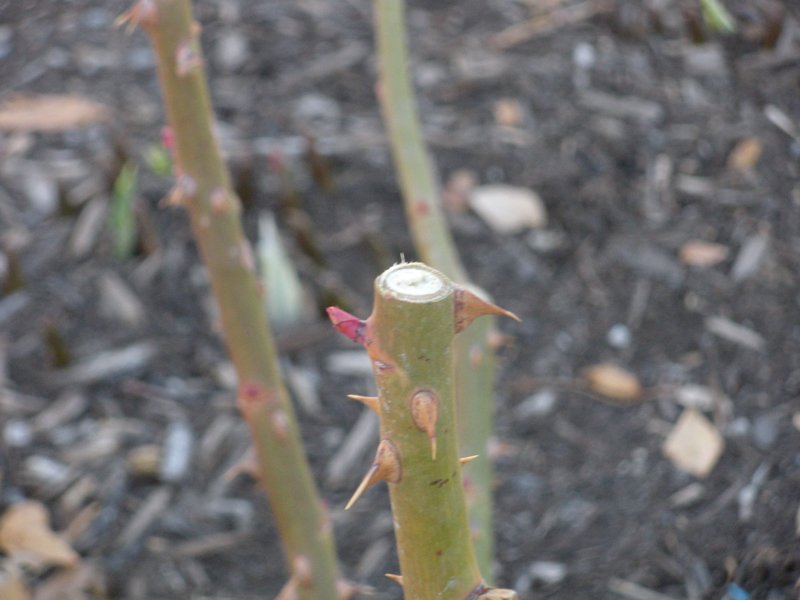
1. A proper cut is made ¼” above a bud. It can be angled or straight across.
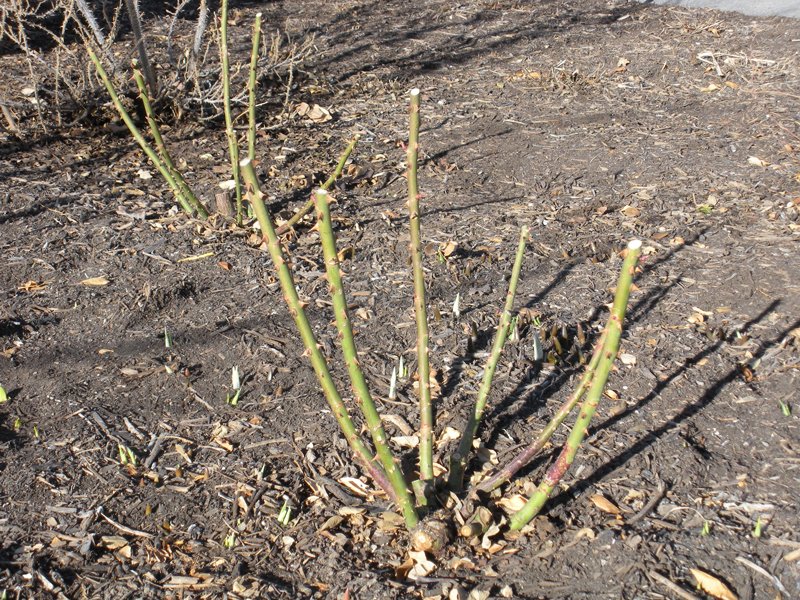
2. A hybrid tea rose after spring pruning. The height and number of canes have been reduced
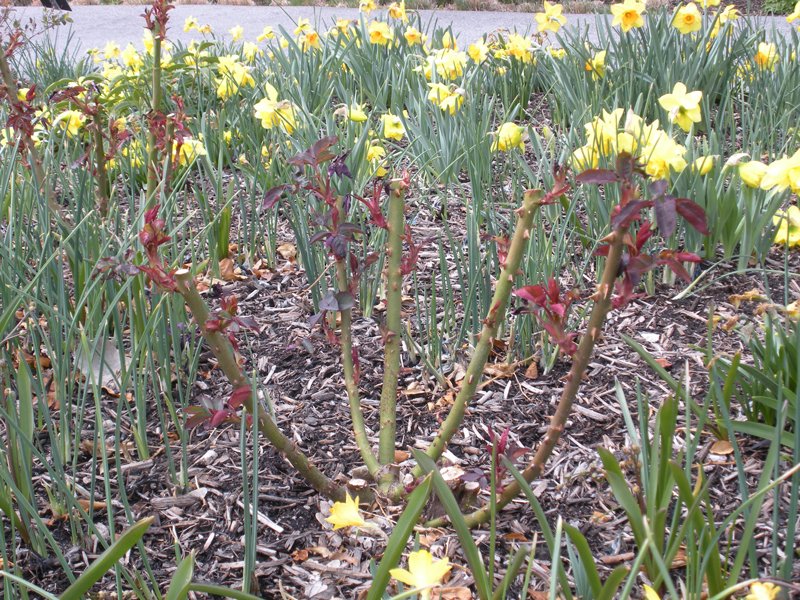
3. New growth emerging on a spring-pruned hybrid tea rose.
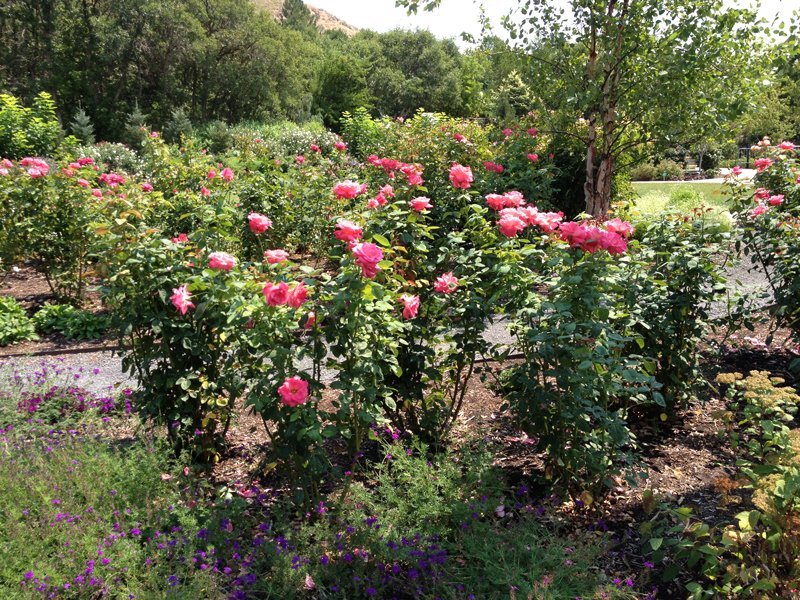
4. Hybrid tea rose in summer bloom. Spring pruning establishes the foundation for good structure and bloom.
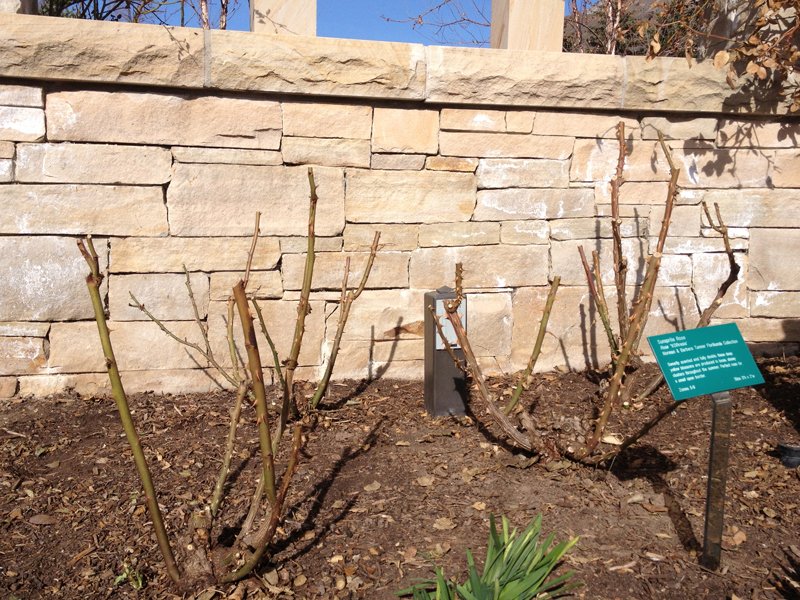
5. A floribunda rose after spring pruning. The height and number of canes has been reduced; however, note that some branching of the canes is still present as this reflects the natural form of a floribunda.
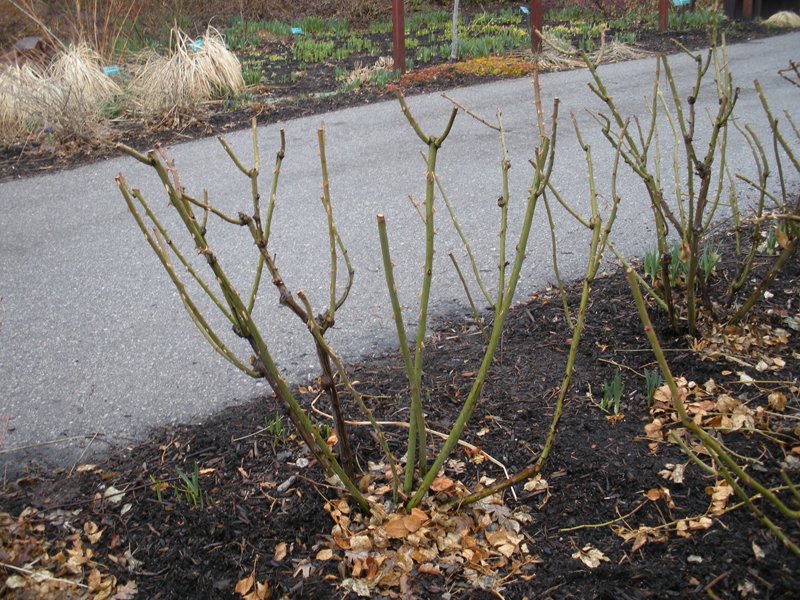
6. A shrub rose after spring pruning. The pruned form follows the natural form of this rose, which is more densely branched.
Pruning Techniques for Specific Rose Types
The most common types of roses are grouped according to bloom time and growth habit. If you do not know what kind of rose you have, take the time to observe its nature. Does it bloom more than once in a season? Does it have very upright canes, or is it bushier with smaller branching and twigs? Does it have quite long canes and vigorous growth? The answers will help you decide how to prune your rose.
Modern bush roses are repeat-flowering roses that should be pruned late winter to early spring as the emerging buds begin to swell. This group includes hybrid teas, floribundas, grandifloras, polyanthas, patio roses, miniatures, and minifloras. Remove any dead, unhealthy, or unproductive shoots, then any shoots that are crossing or crowding the center of the bush. Shorten the remaining canes by one-third to one-half of the overall height. For hybrid teas, floribundas, and grandifloras, remove any small, twiggy growth smaller in diameter than a pencil since it will never support good bloom. With floribundas, the buds may not always be visible on stems that have produced large sprays of flowers. Cut to the approximate desired height, and a nearby dormant bud should be stimulated into life. Polyantha, patio, and miniflora roses are smaller versions of cluster-flowered roses such as floribundas. Prune as for a floribunda, but on a smaller scale. Remove about one-third of growth on main stems. Miniatures require very little pruning, as they naturally have a twiggy growth habit. Remove some congested canes and shorten the height by one-third if desired.
Shrub roses are repeat-flowering roses that should be pruned in late winter to early spring (see photo 6). This group includes modern shrub, English, hybrid musk and rugosa roses. These roses tend to be more densely branched, which will still be evident after pruning. For modern shrub, English, and hybrid musk roses, remove one or two old unproductive canes at the base if needed, and shorten remaining main canes by up to one-third. Little thinning of canes is required. Rugosa roses require little pruning, and even object to heavy pruning. Tip-prune long stems and occasionally remove an old stem completely.
Groundcover roses are repeat-flowering roses that should be pruned in late winter to early spring. Little pruning is required, except to keep plants in bounds. They respond well to hard pruning if necessary for rejuvenation.
Old garden roses have their own particular forms and growth habits that provide an old-fashioned charm to the garden. It is a good idea to get acquainted with your old roses for a couple of years before pruning them, to avoid ruining their natural form. Most old garden roses require only light pruning, if any at all. Prune occasionally to remove old, unproductive canes or to thin overly dense, inner growth. If shoots need to be shortened, prune no more than one-third of their length.
For once-blooming types, such as albas, damasks, gallicas, centifolias and mosses, prune immediately after flowering, July at the latest, so that the plant will have the rest of the summer to produce new growth and flower buds for the following year. Pruning while the roses are dormant will remove flower buds for the coming season. For repeat-blooming types, such as Bourbons, Portlands, and hybrid perpetuals, prune while dormant.
Species of wild roses are once-blooming roses and do not have to be pruned, though they may benefit from occasionally removing an old cane or two to keep them looking good. If you do prune them, do it immediately after they bloom. Next year’s blooms are formed on the growth that occurs the rest of the season.
Ramblers are once-blooming roses and, as such, should be pruned after flowering. They are wild roses or hybrids that retain the character of their wild ancestors. Their vigorous, rampant habit does not require pruning except to keep them in check and reduce the tangle of their long, wild stems. They can be allowed to ramble over large areas or trained as climbers.
Climbing roses need time to build long flowering canes. They may only occasionally require pruning, if ever, as pruning back the long canes frequently will alter the careful training of the climber and reduce overall bloom. These long, arching canes produce lateral side shoots that are the real flowering stems. Pruning of established climbers consists of removing small twiggy canes and old, woody, less vigorous canes at the plant's base. Occasional pruning to control size may be necessary.
Repeat-blooming climbers bloom on the current season’s growth. Pruning of the flowering side shoots can be performed in late winter to early spring. These can be shortened to two to three buds. Old lateral shoots that are no longer productive can be removed completely. Once-blooming climbers flower on wood produced the previous year and should be pruned immediately after blooming if at all.
Pruning is an opportunity to get familiar with your plants so you can help them flourish for years to come. Your confidence and pruning technique will improve, and you will enjoy your roses even more.
For more information and learning opportunities, consider joining the American Rose Society and the Utah Rose Society.